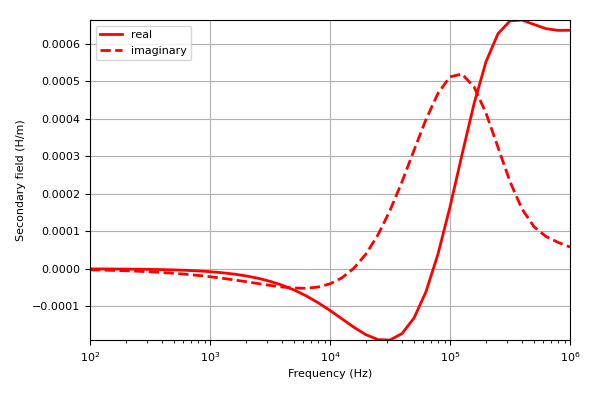geoana.em.fdem.MagneticDipoleHalfSpace.magnetic_field#
- MagneticDipoleHalfSpace.magnetic_field(xy, field='secondary')#
Magnetic field due to a magnetic dipole over a half space
The analytic expression is only valid for a source and receiver at the surface of the earth. For arbitrary source and receiver locations above the earth, use the layered solution.
- Parameters:
- xy(…, 2) numpy.ndarray
receiver locations of shape
- field(“secondary”, “total”)
Flag for the type of field to return.
- Returns:
- (n_freq, …, 3) numpy.ndarray of complex
Magnetic field at all frequencies for the gridded locations provided. Output array is squeezed when n_freq and/or n_loc = 1.
Examples
Here, we define an z-oriented magnetic dipole at (0, 0, 0) and plot the secondary magnetic field at multiple frequencies at (5, 0, 0).
>>> from geoana.em.fdem import MagneticDipoleHalfSpace >>> from geoana.utils import ndgrid >>> from geoana.plotting_utils import plot2Ddata >>> import numpy as np >>> import matplotlib.pyplot as plt
Let us begin by defining the electric current dipole.
>>> frequency = np.logspace(2, 6, 41) >>> location = np.r_[0., 0., 0.] >>> orientation = np.r_[0., 0., 1.] >>> moment = 1. >>> sigma = 1.0 >>> simulation = MagneticDipoleHalfSpace( >>> frequency, location=location, orientation=orientation, >>> moment=moment, sigma=sigma >>> )
Now we define the receiver location and plot the secondary field.
>>> xyz = np.c_[5, 0, 0] >>> H = simulation.magnetic_field(xyz, field='secondary')
Finally, we plot the real and imaginary components of the magnetic field.
>>> fig = plt.figure(figsize=(6, 4)) >>> ax1 = fig.add_axes([0.15, 0.15, 0.8, 0.8]) >>> ax1.semilogx(frequency, np.real(H[:, 2]), 'r', lw=2) >>> ax1.semilogx(frequency, np.imag(H[:, 2]), 'r--', lw=2) >>> ax1.set_xlabel('Frequency (Hz)') >>> ax1.set_ylabel('Secondary field (H/m)') >>> ax1.grid() >>> ax1.autoscale(tight=True) >>> ax1.legend(['real', 'imaginary'])
(
Source code,png,pdf)